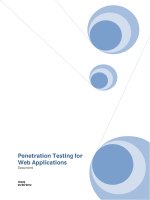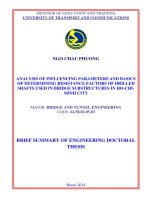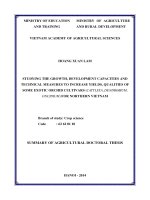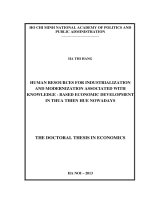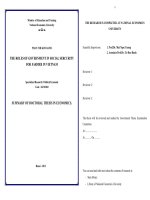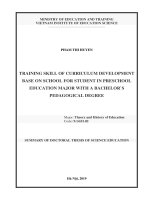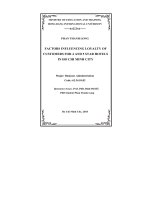Engineering doctoral thesis: Automatic regression testing for Lustre/SCADE applications
Bạn đang xem bản rút gọn của tài liệu. Xem và tải ngay bản đầy đủ của tài liệu tại đây (3.06 MB, 126 trang )
MINISTRY OF EDUCATION & TRAINING
THE UNIVERSITY OF DANANG
------
TRINH CONG DUY
AUTOMATIC REGRESSION TESTING FOR
LUSTRE/SCADE APPLICATIONS
ENGINEERING DOCTORAL THESIS
Da Nang, 8/2018
MINISTRY OF EDUCATION & TRAINING
THE UNIVERSITY OF DANANG
------
TRINH CONG DUY
AUTOMATIC REGRESSION TESTING FOR
LUSTRE/SCADE APPLICATIONS
Major:
Computer Science
Code of Major:
62 48 01 01
ENGINEERING DOCTORAL THESIS
Supervisors:
Assoc. Prof. Dr. Nguyen Thanh Binh
Prof. Dr. Ioannis Parissis
Da Nang, 8/2018
.
REASSURANCES
I hereby certify this thesis done by my work, under the guidance of
Assoc. Prof. Dr. Nguyen Thanh Binh and Prof. Dr. Ioannis Parissis.
I certify that the research results presented in the thesis are true and are
not copied from any other documents. All quotations are recorded clearly and
completely.
PhD. Student
Trinh Cong Duy
-i-
TABLE OF CONTENTS
REASSURANCES......................................................................................................i
TABLE OF CONTENTS ...........................................................................................i
ACRONYMS ............................................................................................................iv
LIST OF TABLES .................................................................................................... v
LIST OF FIGURES .................................................................................................vi
INTRODUCTION ..................................................................................................... 1
1. Context and Motivation ...................................................................................... 1
2. Goals, Objectives and Scope of the Research .................................................... 3
3. Contributions of this thesis ................................................................................. 4
4. Thesis structure ................................................................................................... 5
LUSTRE/SCADE AND REGRESSION TESTING: BASIC
CONCEPTS ............................................................................................................. 7
Testing techniques ............................................................................................ 7
Black-box testing ..................................................................................... 7
White-box testing .................................................................................... 8
Regression testing ............................................................................................ 9
Introduction ............................................................................................. 9
Regression Testing Techniques ............................................................. 12
Regression test selection techniques ..................................................... 14
Regression Testing Tools ...................................................................... 16
Introduction to Lustre/SCADE ...................................................................... 18
Reactive system ..................................................................................... 18
Synchronous programs .......................................................................... 20
Lustre language ..................................................................................... 21
Specification of a software in Lustre ..................................................... 23
Flows and Clocks in Lustre ................................................................. 25
SCADE environment ............................................................................ 27
Structural model in Lustre programs.............................................................. 27
Operator network ................................................................................... 27
Paths in an operator ............................................................................... 29
-ii-
Operator Predicate ................................................................................. 29
Activation conditions............................................................................. 30
Testing Lustre/SCADE programs .................................................................. 32
Test data generation ............................................................................... 32
Coverage criteria for Lustre programs .................................................. 34
Conclusion ...................................................................................................... 36
USING MODEL CHECKER FOR TESTING LUSTRE/SCADE
PROGRAMS ........................................................................................................... 37
Model checking technique ............................................................................. 37
Introduction to model checking ............................................................. 37
Kripke structure ..................................................................................... 39
Temporal logics ..................................................................................... 41
Testing with model checkers .......................................................................... 43
Lesar: Tool for model checking of Lustre/SCADE programs ....................... 46
A solution to generate test data for Lustre/SCADE programs ....................... 49
Using model checker in test cases generation for Lustre/SCADE ............. 49
The AGTC algorithm .............................................................................. 52
Case study .............................................................................................. 54
Conclusion ...................................................................................................... 57
REGRESSION TESTING APPROACH FOR LUSTRE/SCADE
PROGRAMS ........................................................................................................... 59
Motivation ...................................................................................................... 59
Research scope in regression testing for Lustre/SCADE programs .............. 63
Proposed approaches for regression testing ................................................... 64
The GSRS approach .............................................................................. 66
The GSCR approach .............................................................................. 72
The GOPN approach ............................................................................. 78
Conclusion ...................................................................................................... 85
LUSREGTES: A REGRESSION TESTING TOOL FOR
LUSTRE/SCADE PROGRAMS ............................................................................ 86
Introduction .................................................................................................... 86
Test Execution Environment .......................................................................... 86
The LUSREGTES tool ................................................................................... 89
Case studies .................................................................................................... 90
-iii-
Heater Controller System ...................................................................... 90
“U-turn” section management system ................................................... 99
Evaluation summary ..................................................................................... 103
Conclusion .................................................................................................... 104
CONCLUSIONS AND FUTURE WORKS ........................................................ 105
PUBLICATIONS .................................................................................................. 107
REFERENCES ...................................................................................................... 108
-iv-
ACRONYMS
API
Application Programming Interface
AUT
Application Under Test
CARE
Complementarity, Assignment, Redundancy and Equivalence
CASE
Concurrent, Alternate, Synergistic and Exclusive
SCADE
Safety-Critical Application Development Environment
DFA
Deterministic Finite State Automaton
FSM
Finite State Machines
MBT
Model-based testing
NFA
Nondeterministic Finite State Automaton
PFSM
Probabilities Finite State Machine
RBT
Requirement-based testing
SQL
Structured Query Language
UML
Unified Modeling Language
SRS
Software Requirements Specification
SCR
Software Cost Reduction
GSRS
Generation of test cases in regression test using SRS
GSCR
Generation of test cases in regression test using SCR
GOPN
Generation of test cases in regression test using Operator Network
-v-
LIST OF TABLES
Table 1.1. Output for never program ........................................................................23
Table 1.2. The use of the operators when and current [4] ........................................26
Table 1.3. The examples of paths..............................................................................29
Table 1.4. Activation conditions for all Lustre operators .........................................31
Table 1.5. The activation condition from paths. .......................................................32
Table 2.1. Summary of LTL operators .....................................................................42
Table 2.2. Summary of CTL operators .....................................................................43
Table 2.3. Paths of latch program .............................................................................55
Table 2.4. Paths and the correspoding activation conditions ....................................56
Table 2.5. The generated test cases based on activation conditions .........................56
Table 3.1. The test suite for version 1 of the UMS ...................................................70
Table 3.2. Status of test suite in version 2 of the UMS.............................................71
Table 3.3. SCR Event Table for mcPressure ............................................................76
Table 3.4. Modified SCR Event Table for mcPressure.............................................77
Table 3.5. The difference between the two SCR tables ............................................77
Table 3.6. Comparing the GSRS, GSCR and GOPN approaches ............................83
Table 4.1. The Lustre program of version 1 .............................................................91
Table 4.2. The Lustre program of version 2 .............................................................92
Table 4.3. Paths and Activation conditions of version 1 ..........................................93
Table 4.4. Test data for version 1 ..............................................................................95
Table 4.5. The set of paths P2 in new version ...........................................................97
Table 4.6. Set of test data T’’ for regression testing .................................................98
Table 4.7. Paths and Activation conditions of version 1 ........................................100
Table 4.8. Comparingthe LUSREGTES tool with other tools .............................104
-vi-
LIST OF FIGURES
Figure 1.1. Regression testing in software maintenance process [9] ........................12
Figure 1.2. Regression Testing Techniques ..............................................................13
Figure 1.3. A reactive system [29] ............................................................................19
Figure 1.4. Synchronous program [31] .....................................................................20
Figure 1.5. Example of a Lustre program .................................................................23
Figure 1.6. Illustrating a SCADE model and Lustre program [6].............................27
Figure 1.7. Operator network of the “never” node ...................................................28
Figure 2.1. Software Formal Verification Process ....................................................38
Figure 2.2. A typical model checking work-flow [43] .............................................38
Figure 2.3. An example of Kripke structure [45] ......................................................40
Figure 2.4. Creating test cases with model checker ..................................................45
Figure 2.5. SMV Language Example for Train door controller ...............................45
Figure 2.6. The counter-example for Train Door Controller ....................................46
Figure 2.7. An example of Lesar input .....................................................................48
Figure 2.8. Model checking for Lustre program ......................................................51
Figure 2.9. Model of test case generator for Lustre program using activation condition ......51
Figure 2.10. Using Lesar to generate test cases ........................................................52
Figure 2.11. The AGTC algorithm .............................................................................53
Figure 2.12. A Lustre program implementing a latch...............................................54
Figure 2.13. The operator network for latch program ..............................................55
Figure 3.1. Regression testing in a Lustre program development process ...............61
Figure 3.2. Evolution of the Lustre program and regression test ..............................63
Figure 3.3. Test case life cycle in regression testing ................................................64
Figure 3.4. Process to determine the status of the test cases .....................................66
Figure 3.5. Generation of test cases for regression testing .......................................67
Figure 3.6. The UMS system and its environment [4] ..............................................68
-vii-
Figure 3.7. Overall approach for regression testing using SCR ...............................74
Figure 3.8. Two versions of SIS................................................................................76
Figure 3.9. The overall approach of regression testing for Lustre programs ............79
Figure 3.10. Generating and selecting test cases for version 1 .................................79
Figure 3.11. Generating and selecting test cases for version 2 .................................81
Figure 3.12. The AGTR algorithm .............................................................................82
Figure 4.1. The REGTESLUS Testing Environment ...............................................86
Figure 4.2. Module 1 .................................................................................................87
Figure 4.3. The method get the list of paths and respectively activation conditions 87
Figure 4.4. Module 2 .................................................................................................88
Figure 4.5. Algorithm for comparing two sets of path..............................................88
Figure 4.6. The REGTESLUS screenshots ...............................................................89
Figure 4.7. The Heater Controller System architecture [37].....................................90
Figure 4.8. The operator network for version 1 ........................................................92
Figure 4.9. Paths and Activation Conditions in LUSREGTES ................................94
Figure 4.10. The operator network for version 2 ......................................................96
Figure 4.11. The result of the comparison ................................................................96
Figure 4.12. Chart of test cases in regression test .....................................................98
Figure 4.13. The Lustre program for the UMS system .............................................99
Figure 4.14. Paths and Activation Conditions in LUSREGTES ............................100
Figure 4.15. The result of the comparison ..............................................................102
Figure 4.16. Set of test data for regression testing of the UMS system ..................102
-1-
INTRODUCTION
Software testing is an integral phase in software development life cycle of any
application. The purpose of this activity is to ensure that the specifications and
requirements of the software are strictly followed and perfectly implemented. A small
mistake in the software can possibly lead to serious damage and loss of life in some
fields. That is to say, the most important factor that makes a service reliable is
dependability [1]. This thesis is inspired by this context. To be more specific, we
mainly focus on synchronous programs written in the Lustre language, a class of
reactive systems, and we study the improvement of testing in this field with a special
interest in the domain of avionics.
1. Context and Motivation
In high-risk applications of industries as automotive, energy and avionics,
systems are normally of type command and control. This kind of systems requires
good synchronization between the systems and their external environment to avoid
failures which may result in malfunction or unwanted issues. In order for the latter
changes to be taken into account, software reaction to the information supplied by the
environment should be done in real-time (theoretically instantaneous). This property
is defined as synchronism and is a characteristic of synchronous reactive systems that
are usually involved in safety critical systems. With a view to properly modeling and
specifying this kind of systems, Esterel [2], Signal [3] and Lustre [4, 5] among several
synchronous programming languages have been proposed. This thesis in its context
focuses mainly on Lustre language.
Lustre is a formal declarative and synchronous dataflow programming
language that can be also used as a temporal logic of the past. Variables and
expressions are represented by data flows, that is, infinite sequences of values whose
evaluation is governed by a discrete global clock. As opposed to imperative languages
that describe a program’s control flow, Lustre shows the way that its inputs are
converted into the outputs at each instant of the global clock. Moreover, this cyclic
-2-
behavior along with the deterministic nature of the language and its formal semantics
make it very suitable for programming reactive synchronous applications with similar
features. The structure of a Lustre program is graphically represented by an operator
network. An operator network is an oriented graph; the nodes denote the operators
used in the program and the edges connecting the operators denote the transfer of data
among them.
Lustre is the core language of SCADE (Safety-Critical Application
Development Environment) [6], an industrial tool suite widely used for the
development of real-time reactive systems. This SCADE environment makes it
possible to hierarchically define the software elements and automatically generate the
code. Despite the non-standardization, C code is automatically generated from
SCADE. This graphical modeling environment is primarily used in airborne systems
(Airbus, DO-178B standard [7]) and is becoming a key standard in this field.
In safety-critical applications, the design of the systems requires much effort.
In the last decades, the use of formal methods and model-based techniques for
designing, analyzing and implementing major industrial systems became broader.
Together with the development cycle of such applications, the verification and
validation process is essential but costly and time-consuming. Especially, software
testing is a method of verification and validation that could help revealing defects in
the system or to demonstrate the conformity of the model with the implementation
and get confidence in the final product.
Software maintenance is the last stage of software life cycle aiming at,
correcting errors, making modifications to functionality and deleting existing
features. These changes may cause the system to work inaccurately. Thus, there is a
need for regression testing. Regression testing purpose is to make sure that the
changes and modifications to the software did not introduced new bugs. In addition,
one of the main targets of regression testing is to figure out whether a change in one
module influences other modules of the system. Common methods of regression
-3-
testing include re-running previous sets of test cases and checking whether previously
fixed faults have re-emerged.
Regression testing can be applied for testing a system efficiently by
methodically selecting the proper minimum test sets needed to cover a specific
modification adequately. Our objective is to determine a regression testing method
detecting the most possible errors with the minimum number of test data.
This thesis aims at studying regression testing process issues with a focus on
automating test data generation, in the framework of reactive real-time systems
developped in the Lustre/SCADE language.
More precisely, the topic "Automatic regression testing for Lustre/SCADE
applications" has been selected for this thesis to contribute to the development and
application in software industry, software testing in general as well as regression
testing in particular and particularly regression testing for the reactive systems - an
approach that promises to deliver high effectiveness in software quality assurance.
2. Goals, Objectives and Scope of the Research
The objective of this thesis is to figure out automatic regression testing
techniques. On that basis, we propose a solution for generating test data in regression
testing for Lustre/SCADE applications. As a result, the objectives of the thesis are to
propose automatic regression testing techniques in the Lustre/SCADE environment.
To do so, we proceed in the following steps:
− Firstly, we study a state of the art on regression testing and regression
testing techniques.
− Secondly, we analyze the features of reactive systems, the synchronous
approach, the Lustre language and SCADE environment; we study the structural
coverage of Lustre programs and the activation conditions of paths on operator
network of the equivalent Lustre program.
− Thirdly, we focus on using model checking in software testing. The thesis
proposes the approach of using model checking to generate the test data based on the
-4-
activation conditions in operator network of Lustre/SCADE programs.
− Finally, the state of the art on test data generation is also figured out, then we
propose an approach to generate test data in regression testing for Lustre programs. In
this approach, a Lustre program is modeled by an operator network. Then we determine
its set of paths and compute symbolically the path activation conditions for each
version. Test cases for regression are generated by comparing paths between versions.
To validate this solution, we have developed a tool named LUSREGTES.
3. Contributions of this thesis
− The general idea of using model checking in software testing is not new.
However, with this research, instead of using modeling languages to build models of
Lustre programs and LTL properties that define trap properties, we have suggested
the solution which uses activation conditions on the operator network from Lustre
programs, combined with the use of a model checker to create test data for
Lustre/SCADE programs. The thesis proposes also the AGTC algorithm, which
automates test data generation. This solution and AGTC algorithm helps removing
the manual inputs definition in the model checking, as well as saving time and effort
since this solution could be fully automated.
− Based on the analysis of the characteristics of Lustre/SCADE programs, the
thesis proposes a solution to generate test cases for regression testing of
Lustre/SCADE programs. We propose and experiment three approaches: GSRS Generation of test cases in regression test using software requirements in natural
language; GSCR - Generation of test cases in regression test using SCR; GOPN Generation of test cases in regression test using operator network. We have compared
the three approaches, identifying the appropriate and inappropriate characteristics of
each approach to our problem. Most importantly, we can propose the most suited
solution to automate the process of generating test data for regression test based on
special characteristics of Lustre programs which are operator network, paths in the
operator network and activation conditions.
− With the GOPN approach, we identify the correlation among activation
-5-
conditions of paths on the operator network and test data. When the changes appear
upon Lustre/SCADE program, we identify which data have just been removed, reused from the old version or need to be created.
− The GOPN approach was implemented in the tool, called LUSREGTES.
The tool automatically creates test data for regression testing of Lustre/SCADE
programs, identifies test data which should be removed and re-used. Commonly, in
the development process, the number of test cases raises after each change and
becomes larger and larger which leads to increase in the costs of regression test. This
tool helps removing the unnecessary test data; therefore it saves considerable time
and effort for regression testing process.
4. Thesis structure
In addition to introduction, conclusion and future work sections, the structure
of thesis contains the following chapters.
Chapter 1: Lustre/SCADE and Regression testing: basic concepts. This
chapter presents the fundamental concepts of regression testing, the techniques and
application of regression testing as well as a state of the art on this testing technique.
Beside that, the chapter introduces the overview of Lustre/SCADE environment, the
features and basic components of Lustre programs and SCADE environment. In
particular, we focus on introducing the contents related to the Lustre language, such
as: Operator network, paths and activation conditions. Besides, we present some
methods and tools for test data generation and coverage assessment.
Chapter 2. Using model checker for testing Lustre/SCADE programs. Model
checkers are formal verification tools, providing counter-examples violating
properties. Normally, these counter-examples are meant to guide an analyst when
searching for the root cause of a property violation. In this chapter, we have proposed
an approach to use a model checker to generate the test cases for Lustre/SCADE
programs.
-6-
Chapter 3. Regression testing approach for Lustre/SCADE programs. This
chapter presents the solution to generate test cases in regression testing of Lustre
programs. We studied and proposed three approaches: GSRS, GSCR and GOPN. We
have compared three approaches, assessing the strengths and weaknesses of each
approach. Then select the appropriate approach to solve our problems.
Chapter 4. LUSREGTES: a regression testing tool for Lustre/SCADE
programs. Chapter 4 presents the LUSREGTES tool for regression testing
Lustre/SCADE programs implementing and illustrating the solution that has been
proposed in Chapter 3.
-7-
LUSTRE/SCADE AND REGRESSION TESTING:
BASIC CONCEPTS
Testing is a verification and validation process, which includes implementing
a program with the purpose to find errors [8]. Regression testing is applied during
maintenance phase and crucial when application has been modified. Regression
testing makes sure that the changes made on the program have no impact on other
parts that were earlier working fine. In this chapter, several testing techniques and
regression testing are thoroughly discussed. Besides, we introduce essential
characteristics of synchronous reactive software and basic notions concerning the
Lustre language and SCADE environment. In particular, we focus on introducing the
contents related to Lustre, such as: operator networks, paths and activation
conditions. In addition, we present some methods and tools designed for test data
generation and coverage assessment.
Testing techniques
Software testing purpose is to evaluate an attribute or quality of a program or
system and conclude that it satisfies the desired result. Although software testing is
important, it remains an art due to limited understanding of the principles of software.
It is impossible to find all errors of a program (even a trivial one) by testing. The
process of stimulating all the valid and possible conditions in which a program may
be exposed to so as to execute it and observe the results is considered highly difficult.
Therefore, the objective of any testing technique is to find the maximum number of
defects in the minimum period of time with the smallest cost. Most typical testing
techniques are divided with regard to the way test data are selected. Specificationbased selection of test data makes black-box testing whereas code-based data
selection concerns white-box testing.
Black-box testing
Black-box testing techniques treat program under test as a black box without
knowing its internals, that is, final program structure [9]. It is also named as data-
-8-
driven, input/output driven, or requirements-based testing [10]. Because of the only
concern on the functionality of the software module, black-box testing is also known
as functional testing, since functions are tested by feeding them with inputs and
examining the output regardless the program structure. Therefore, it separates between
user’s and developer’s perspectives.
Theoretically, it is possible to exhaustively test a subset of the input space and
this can detect all existing program errors. However, this could not ensure that the
program is bug free, because we may fail to write down all the possible cases in the
specification. Hence, due to the unfeasibility of exhaustive input testing, several
techniques are used to select a test data set as complete as possible.
Random testing, equivalence partitioning and boundary-value analysis are among
some of the most prevalent black-box testing methodologies. Random testing is often
described as the simplest and the least effective testing methodology. It involves
randomly selecting some subset of all possible input values to test a program [11].
Random input testing is inefficient in terms of code coverage and fault detection [12].
Equivalence partitioning is relying on the idea of identifying the most suitable set of test
data with the highest fault detection probability. This method implies the division of a
program input domain into a finite number of equivalence classes. If a test case in an
equivalence class finds an error, all other test cases of the same class would be expected
to find the same error and vice versa.
White-box testing
In this testing approach, program is considered as a white (transparent) box as the
tester can view the structure and flow of the program under test. To make test plans, the
tester must follow the details of the software implementation, such as programming
language, logic, and styles. Test cases are obtained from the software structure. Other
names of white-box testing are logic-driven testing or design-based testing [8].
As opposed to black-box testing, white-box or structural testing is carried out
in depth to the level of the source code and test data selection is only driven by the
-9-
latter. This form of testing does not check for missing requirements or specifications.
White-box testing techniques are principally based on the structural coverage of the
control flow graph of the software under test; they check how much test cases exercise
or cover the program control flow. Each node in a control-flow graph represents a set
of sequential executed program statements (i.e. a piece of code without any branch
statement). Edges or arcs are used to represent branches in the control flow. In this
case, testing a program exhaustively (similar to black-box testing) would be identical
to execute, via test cases, all possible paths of control flow (path coverage). However,
it is not always possible or useful for this. In fact, the number of paths in a program
could be very large, especially in real programs that contain several loops, and this
makes complete path testing impossible.
Regression testing
Introduction
Regression testing is the process of re-testing a piece of software to ensure its
quality and check whether changed parts work as intended and unchanged ones are
not influenced by the modifications. Since this is an expensive process, several
techniques have been proposed to advise the testers on how to build regression test
suite from existing test suite at the lowest cost. Regression testing is implemented
after modifications are made to a software system; and before releasing new version
of the system, regression test can be used [9]. However, testers do not have much
time to perform this regression testing as such modified systems are released quickly.
Therefore, they may use a random-testing technique to perform regression testing.
The fact that regression testing is inadequate can result in bugs in untested modules
of the program to be exposed only during production or field usage. For the regression
test to be more efficient, and then to enable its use before release, it is essential to
present techniques to select and run only test cases which are relevant to the
modifications or prioritize the test cases based on criticality or perceived
effectiveness. Some representations of the software such as a system model or the
-10-
source code are often used by these techniques to perform the selection and
prioritization of test.
It is crucial to perform regression testing to make sure the modifications did
not cause regression of not related components while software evolves (change of
components or integration of new components). An analysis of regression may help
choosing which test must be re-implemented in order to re-test the parts affected by
the modification. In the case of version change, regression testing ensures that the
changes did not engage unwanted reactions that affect the behavior of the application
validated before. The original collection of test cases needs to be re-executed to
ensure that the software always satisfies the requirements. Nevertheless, it is quite
resource-consuming to re-run the entire set of test cases. Because of this, a technique
to select a subset of existing selected test cases to reduce cost and improve
effectiveness should be used.
Regression testing is performed to selectively retest the software after verification
of changes to ensure that fixed errors do not unintendedly influence the remaining
functionality of the modules and also the functionality of the same module [10]. Thus,
regression testing aims at identifying changes in order not to test again unchanged parts
already tested and, hence, to cut down cost.. Regression testing not only selectively
retests the program to check if it is conforming to the new specification, but also
improves the confidence of the clients that the software product can be modified
according to their requirements and the environment [11]. By carrying out regression
testing effectively, the developer will also see the implications and consequences of the
modifications that have been made. The cost of testing can be reduced if existing test
cases are reused for new test case generation. This also helps making less costly the
process of creating test case execution set-up, building oracle and crafting data that can
be used [11]. A repeated process of purification will be performed during the
development life cycle of the software. Therefore, the duty of the programmer is to pay
close attention to produce highly qualified error free software and this may require the
use and combination of many testing techniques at various levels. Regression testing can
-11-
be applied at any level of testing i.e. unit testing, integration testing, and system level
testing. Unlike development testing, an existing test suite in regression testing is available
for reuse [12]. According to a recent study, regression testing and maintenance of the
product accounts for about 80% of testing budget and one-third of the total cost of
software development [13]. There are many techniques in the literature for maintenance
and regression testing of software. Most of the work has been done on code based
regression testing in which test suites are built according to the delta change between the
original code and the modified code. A survey on code based regression test selection
techniques is provided by Rothermel and Harrold [14]. The main effort is to reduce the
cost of testing by selecting a cost minimizing subset of test cases for regression testing
[11]. Besides cost, a trade-off between the selection and execution of test cases and the
fault detection ability of the test cases that are executed must be found. There are many
factors that affect cost-effectiveness of testing. Rothermel et al. determined the effect of
collecting of test inputs into test cases on the cost-effectiveness of regression testing
techniques [15].
Although regression testing is usually associated with system testing after a
code change, regression testing can be carried out at either unit, integration or system
testing levels. The sequence of activities that take place during the maintenance phase
after the release of software is shown in Figure 1.1. The figure shows that after
software is released, the failure reports and the change requests for the software are
compiled, and the software is modified to make necessary changes. Resolution tests
are carried out to verify the directly modified parts of the code, while regression test
cases are carried out to test the unchanged parts of the code that may be affected by
the code change [9]. After the testing is complete, the new version of the software is
released, which then undergoes a similar cycle.
-12-
Figure 1.1. Regression testing in software maintenance process [9]
Regression testing is required when there is:
− Change in requirements and code is modified according to the requirement;
− New feature added to the software;
− Defect fixing;
− Performance issue fixing.
Regression Testing Techniques
Let P be a program, let P’ be a modified version of P, and let T be a test suite
for P. A typical regression test procedure consists of the following steps:
1. Select T’ ⊆ T, a set of test cases to execute on P’;
2. Test P’ with T’, establishing the correctness of P’ with respect to T’;
3. If necessary, create T’’, a set of new functional or structural test cases for P’;
4. Test P’ with T’’, establishing P’’ correctness with respect to T’’;
5. Create T’’’, a new test suite and test execution profile for P’, from T, T’, and T’’.
Different steps involve different important problems of regression testing.
Step 1 involves the regression test selection problem: to select a subset T’ of T. Step
2 and Step 4 address the test suite execution problem: to efficiently execute the test
suites and checking test results for correctness. Step 3 involves the coverage
identification problem: to identify whether P’ has new functionalities which require
new test cases. Step 5 addresses the test suite maintenance problem: to update and
store test information.
-13-
Figure 1.2. Regression Testing Techniques
Note that regression test selection is applicable both in cases where the
specifications have not changed, and where they have changed. In the latter case, it is
necessary to identify the test cases in T that are obsolete for P’ prior to performing
test case selection. Test case t is obsolete for program P’ if and only if T specifies an
input to P’ that is invalid for P’, or T specifies an invalid input-output relation for P’.
Having identified these test cases and removed them from T, regression test selection
can be performed on the remaining test cases. Note that the identification of obsolete
test cases is necessary if any test case reuse is desired (whether by test selection or
retest-all).
There are various regression testing techniques [16]: (1) Retest all; (2) Regression
Test Selection; (3) Test Case Prioritization; (4) Hybrid Approach (Figure 1.2).
Retest All: This is one of the methods for regression testing in which all the
tests in the existing test bucket or suite should be re-executed (re-use all previously
developed test suite T, executing on the modified program P’). Retest all method is
one of the conventional methods for regression testing in which all the tests in the
existing test suite are rerunned. So the retest all technique is very expensive as
compared to techniques which will be discussed further as it requires more time
and budget.
-14-
Regression Test Selection: Due to the expensive nature of the “retest all”
technique, Regression Test Selection (RTS) is performed. In this technique instead
of rerunning the whole test suite we select a part of test suite to rerun if the cost of
selecting a part of test suite is less than the cost of running the tests that RTS allows
us to omit. RTS divides the existing test suite into (1) Reusable test cases; (2)
Retestable test cases; (3) Obsolete test cases. In addition to this classification RTS
may create new test cases that test the program for areas which are not covered by
the existing test cases. RTS techniques are broadly classified into three categories.
−
Coverage techniques: they take the test coverage criteria into account.
They find coverable program parts that have been modified and select test cases that
work on these parts;
−
Minimization techniques: they are similar to coverage techniques except
that they select minimum set of test cases;
−
Safe techniques: they do not focus on coverage criteria, in contrast they
select all the test cases that produce a different output with a modified program as
compared to its original version.
Prioritization of Test Cases: Test cases prioritization depends on business
impact, critical and frequently used functionalities. Selection of test cases based on
priority will greatly reduce the regression test suite.
Hybrid Approach: The fourth regression technique is the Hybrid Approach of
both Regression Test Selection and Test Case Prioritization.
Regression test selection techniques
In this section, we study the regression test selection techniques as well as we
give a try on finding relevant techniques or concepts that can be applied appropriately
in our context. Many techniques for regression test selection have been studied by
researchers. In this section, we will present briefly some main techniques [17]:
− The Path Analysis technique: The Path Analysis technique [18] has been
used for unit testing of imperative programs. This technique takes as input the set of
-15-
program paths in P’ expressed as an algebraic representation, and manipulates this
representation to derive a set of cycle-free exemplar paths: acyclic paths from
program entry to program exit. The technique then compares exemplar paths from
original P to exemplar paths from modified P’, and categorizes paths as new N,
modified M, canceled C, or unmodified U. Next, the technique analyzes tests to
determine association between paths and test case.
− Dataflow techniques: The data-flow techniques [19, 20] use a control flow
graph to represent the program under test. These techniques rely on the definition-use
pairs along program paths. They compare definition-use pairs of the original program
P to definition-use pairs of the modified program P’ to identify: new, modified or
deleted definition-use pairs. If a definition-use pair has been added or modified, tests
cases are then selected. These techniques can be applied for Scade or Simulink
models: the definition-use pairs are much easier to study for declarative programs
(each variable is defined once and only once).
− Program Dependence Graph Techniques: In [21], the authors’ objective
is to select a set of test cases to be executed again in order to test a modified program.
This approach has been applied for unit testing of imperative programs.
− Semantics guided selection technique: This technique is for interprocedural regression testing [22]. It appears to be an extension of Program
Dependence Graph so that procedures can be taken into account. Additionally, the
way to capture the difference between the initial program and the modification relies
on “semantic” difference in presence of procedures.
− Cluster Identification Technique: This technique was proposed by Laski
and Szemer [23]. It is based on the comparison of control flow graphs (CFG) for original
program and modified one. The technique uses a notion of cluster (single-entry, singleexit subgraph) and compare the clusters of P and P’ for their correspondence. This
technique has been applied at the unit testing of imperative programs.
